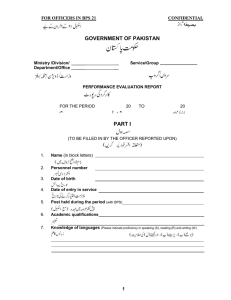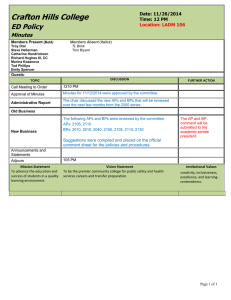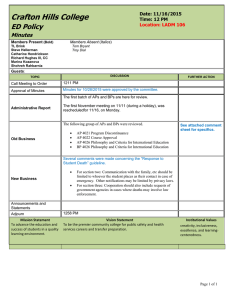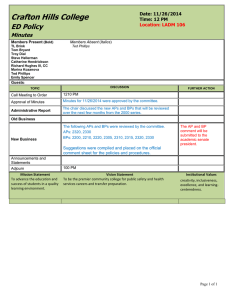The CONNEXION Project - Complex Systems Design
advertisement
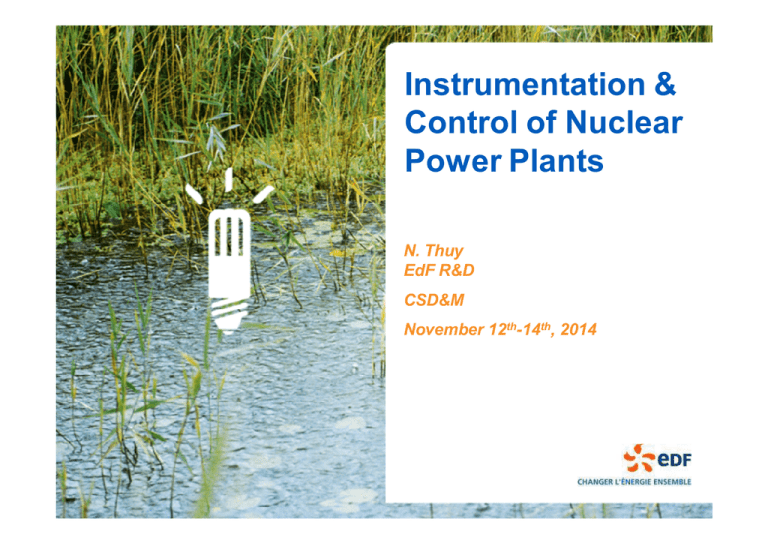
Instrumentation &
Control of Nuclear
Power Plants
N. Thuy
EdF R&D
CSD&M
November 12th-14th, 2014
Nuclear Power Plants as Complex Systems
From initial concept to operation: 10+ years
Construction per se: 6 or 7 years
Expected lifetime: 60+ years
Strong safety and security regulatory requirements
But significant differences between national regulatory bodies, and even within the same
regulatory body
250+ plant systems, involving a wide range of scientific and engineering
disciplines
Electrical engineering, civil engineering, thermohydraulics, chemistry, nuclear physics,
aerodynamics, ....
Cross systems concerns
Operation and maintenance (including periodic testing), socio-organisational and human
factors, risk & hazards analysis, vulnerability and security analysis, failure analysis,
instrumentation and control (I&C), ...
Systems Engineering
Hazards &
Safety Analysis
- Vulnerability &
Security
Analysis
Plant Concept
- Safety &
Security
Concepts
Socio
Organisational
& Human
Factors
Engineering
Probabilistic
Risk Analysis
Disciplinary
methods, models
and tools
Overall
Plant Design
Cross-disciplinary
models
• Design decisions
• Expectations
Plant
Operation &
Maintenance
Concepts
Design decisions
Expectations regarding inputs
Inputs from other
disciplines
Process
Design &
Functional
Analysis
Instrumentation
& Control
Thematic VAST
•
•
•
•
Verification
Analysis
Simulation
Testing
Multi-physics simulation
Physics-Controls-Procedures simulation
Probabilistic Safety Analyses
Resilience analyses, FMECA
Safety justification, Security justification
Hardware-in-the-Loop testing
Validation testing, Statistical testing
Human factors analyses
Construction planning
Cost estimations, ...
The I&C Challenges
10 000+ signals
Several thousands I&C functions
10+ different I&C systems
Totaling several hundred cabinets
Interact with nearly all plant systems
Need to address all plant situations
Normal plant states: commissioning, starting up, intermediate power levels, normal
power, shutting down, ...
Periodic testing and calibration, maintenance during operation, outages, ...
Abnormal states: equipment failure, incidents, accidents, severe accidents
Subject to requirements and constraints from many other disciplines
Changes more frequent than in other disciplines
Product and technological evolution
I&C as a solution for improved plant performance, resiliency, safety, ...
Digital I&C is the focus of regulatory suspicion
I&C studies represent a significant part of the design cost of a new
power plant
Examples of I&C Engineering Topics
Overall I&C architectural design
Organisation of the 10+ I&C systems into a safe, secure, functional, resilient whole
Levels of defence-in-depth / security zones, safety classification / security degrees, diversity, data
communications, human-system interfaces, ...
Minimising, as far as reasonably feasible, the need for country specific features
Individual I&C systems architectural design
Several thoudand functions, 100+ cabinets
Optimisation: minimise the number of necessary cabinets
Satisfy performance requirements, taking into account the processing required, inputs/outputs, and
the characteristics of the platform chosen
Segmentation to reduce potential for complete system failure
Logical design verification
Including system architecture, software, FPGA logic, executable binary code
Testing, formal verification, proven compilers and generation tools, ...
Design of Human-System interfaces
Probabilistic safety modelling and analysis
Verification of I&C functional and timing requirements
Why is That Necessary?
Experience from multiple industrial sectors shows that functional requirements
are sometimes inadequate
Even for highly dependable systems
Errors will be revealed late in the development process, or worse, during operation
Such weaknesses result from multiple causes
E.g., functional complexity or inadequate understanding or analysis of I&C system environment and
operational context
Evolutionary designs limit the risk
But radically new designs need to address the issue more explicitly
One objective of the FP7 HARMONICS, ITEA2 MODRIO and CONNEXION
projects is to enhance confidence in I&C functional and timing requirements
By regulation, to
Wheels on the
prevent spurious ground
Thrust
deployment while
reversers in
airborne, hydraulic
operation
circuits of thrust
reversers are
disabled
Pilots see a snow
Wheels no longer on
plough on the tarmac
the ground
They disengage the
Hydraulic circuits
thrust reversers and
disabled.
take-off
Reverser on one side
is fully folded, but not
on the other side
Aerodynamic pressure
reopens the thrust
reverser Airplane is
thrown off balance,
pilots do not have
time to react
Small airport, No local control tower, Snowing, Poor visibility
Overall Approach
Consider the functional and timing requirements for I&C in the
framework of those of the parent plant system, and of the assumptions
that system makes on its own environment
Including human actions, generally following specified operational procedures
Formal requirements and behavioural modelling
(Massive) use of co-simulation to verify that requirements are satisfied
Physical processes, Human actions (and operational procedures), Automatic control
Also for
STPA (System Theoratical Process Analysis)
FMECA (Failure Modes, Effects and Consequences Analysis)
System validation (hardware-in-the-loop)
...
Step 1 - Non-Formal Plant System Analysis
Identification & characterisation of
a plant system environment
All entities that interact with it (e.g., other
plant systems, human operators)
Identification & characterisation of
operational modes
Situations with specific behaviour and
expectations
Including failure and abnormal situations
Assumptions and requirements may
depend on operational modes
A plant system needs, and
assumes, certain behaviour from
other plant systems or from
operators
Once agreed, these assumptions
become requirements for the other
plant systems or for the operators
Plant
Operator
A plant system is designed
based on the requirements placed
Requirement
on it, but also on the assumptions
Contract
it makes
Assumption
Contract
Client
Plant
System
Assumption
Contract
Requirement
Plant
Assumption
System
under study
Requirement
Supplier
Plant
System
Step 2 - Plant System Requirements Modelling
Formal modelling of the plant system and its environment
Object(s) representing the plant system
Objects interacting with the plant system and representing its environment
Operational modes
Assumptions on the plant system environment
Requirements regarding the plant system
At this stage, this is preferably not an imperative, deterministic model
To avoid over-specification and the precluding of possible solutions
Formal modelling often helps improve the informal requirements
specification
Tool assisted verification may be used to detect overly constrained
models (no possible solution), inconsistencies,
incompleteness, ...
Deterministic behavioural model
Non-deterministic requirements model
Step 3 - Plant System Overall Design Modelling
Identification and characterisation of the plant system main components
Including Instrumentation & Control
Identification and characterisation of the plant system main internal
modes
Plant System
Assumptions made on each component
under study
Requirements, from the component standpoint
Allocation of plant system requirements
First in a non-formal manner, and then in a formal model
Here again, preferably not an imperative, deterministic model
Multiple design alternatives may be modelled and
analysed
Equipment
Equipment
Equipment
I&C Functions
I&C
System
Step 4 - Plant System Overall Design Verification
Co-simulation of the requirements model and the overall design model
Stimulation using a random generator of conformant scenarios
Such as StimuLus (from ArgoSim)
Conformant to assumptions made
regarding the plant system environment
and plant system components
Verification that the overall design
satisfies the plant system
requirements
The I&C functional and timing requirements
specification are part of the plant system
overall design
Application of coverage criteria
Plant System
Requirements
Assumptions on
Plant System
Environment
Plant System
Overall Design
Assumptions
on Plant
System
Components
Random
Generator of
Conformant
Behaviours
Simulation
Results
Analyser
Simulation
HSI
Specification
of Simulation
Objectives &
Scenarios
Step 5 - Detailed Design and Verification
As design becomes more detailed, the precise behaviour of individual
components can be represented by deterministic, behavioural models
E.g., in MODELICA for the physical process
In functional diagrams for I&C functions
Detailed design decisions just need to comply with the overall design
Modelling
Process models
Models based on ad hoc techniques
Models based on general, multi-physics modelling languages, e.g., MODELICA
Multiple models can cooperate using the FMI (Functional Mock-up Interface)
MODELICA is being extended by the ITEA2 project MODRIO
FOrmal Requirements Modelling Language (FORM-L), to formally specify requirements
and assumptions at process level
Stochastic modelling, to model random events such as components failures
Multi-mode modelling, to facilitate the representation of components failure modes
FORM-L
The language allows the expression of
Requirements to be satisfied
Functional & timing requirements
Fault-tolerance and probabilistic requirements
Assumptions made on the environment of the system
Overall design decisions
Such as allocation of requirements to system components
Designed to be undertandable by application domain experts
Who are not necessarily modelling experts
Graphic version of the language allowing different graphic styles and natural languages
(dialects)
FORM-L Main Concepts
FORM-L addresses four main questions: WHAT, WHEN, WHERE and
HOW WELL
WHAT
Boolean conditions
Duration of Boolean conditions
Constraints on the number of occurrences of an event
WHEN (temporal logic)
During time periods (with duration)
At particular instants (without duration)
During "sliding time windows"
WHERE
Sets of objects concerned
Set memberships often not know at requirements specification
HOW WELL
Fault tolerance
(Conditional) failure probabilities
BPS, a Detailed Case Study - Requirements
The BPS (Backup electric Power Supply) provides electric power to
Backed-up Components (BCs) in case of loss of Main Power Supply
(MPS)
Operator
SICS
P3a: When in operation, and when the BPS is not under
maintenance, BC1 should not be without power for more
than 30 seconds per any 30 minutes time period
R3a: When there are no BPS components failures, or at most
a single sensor failure, P3a is required
R4: The probability of not satisfying P3a must be less than
10-3 per demand
Non Backed-up
Electric Panel
Backed-up Electric Panel
MPS
BC1
DG
BPS
BC2
BC3
BC4
BC5
BC6
BPS Overall Design
The DGLS (Diesel Generator Load Sequencer) is the control system of
the BPS
It operates in a discrete time domain
The BPS overall design specifies requirements for the DGLS
BC 1
MPS
DG
DGV
DGF
NBV
BV
Step1
Step2
BC 2 - 5
Step3
Step4
Step5 Step6
BC 6
Step7
Step8
BV
BPS
Backed-up Electric Panel
Non Backed-up
Electric Panel
Operator
DGLS
SICS
Step9
I&C Requirements Specification in FORM-L
DGLS-R9: When reloading is allowed, the required, unpowered Step
with the highest priority shall be reloaded within 100 ms
When there are remaining required, unpowered Steps
An unrequired Step may become required at any moment
Boolean reloadingAllowed;
class Step
Boolean required;
Integer priority;
Breaker brk;
end Step;
class Breaker
event openOrder;
event closeOrder;
fsa state = {open, closing, closed, opening} ... end
...
end Breaker;
Step step[9]
....
// initialiation
end step;
Step stepsToBeReloaded = {s ∈ step | s.required and not
Integer maxPriority = max{stepsToBeReloaded.priority};
Step candidate = any{s ∈ stepsToBeReloaded | s.priority
requirement R9 =
when (reloadingAllowed and card(stepsToBeReloaded)>0)
within ms100
check candidate.brk.closeOrder;
state;
s.brk.state=closed};
= maxPriority};
becomes true
BPS Formal Models
BPS.REQ
Requirements &
Environment
implements
BPS.ODS
Overall Design
(FORM-L)
(FORM-L)
stimulates
BPS.ENV
Environment
(StimuLus)
stimulates
BPS.REQ
Requirements &
Environment
implements
(FORM-L)
(FORM-L)
stimulates
implements
BPS.BEV
Detailed Design
BPS.ENV
Environment
(StimuLus)
BPS.ODS
Overall Design
stimulates
(Modelica +
Functional Diagrams)
Conclusion
More explicit statement of WHY I&C requirements are as they are
Particularly useful when systems are revisited (for upgrades for example) many years
after initial development
Helps identify possible impacts of plant systems modifications on I&C
The same models may be used for various purposes
Improve confidence in requirements
Early design functional verification
Probabilistic and failure analyses
FMECA
Hardware-in-the-Loop testing
...
